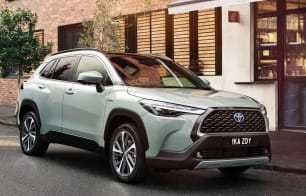There are a lot of ways in which the C-HR is more practical than its Corolla hatch sibling, but some areas where it could definitely do better in the small SUV space.
While many will appreciate the ride height on offer from the C-HR, the front of the cabin feels quite claustrophobic thanks to the abundance of black trim, and the design of the dash cladding and centre console means it suffers from the same lack of storage as its Corolla relation.
The big swooping piece of plastic trim down the centre only houses two large bottle holders, a small centre console box, and that’s about it.
Where this area meets the dash, there’s a lot of cladding bits where there should be a storage cutaway. There’s even an odd little shelf, but I’m not sure what it’s for because it’s tiny and hard to access. Odd.
Like the Corolla, this car’s climate controls float atop the angled dash piece, tastefully finished in that signature rhomboidal pattern.
And thankfully the new and improved screen is much easier to use than the small one it replaces from the pre-update model. It even has dials for volume and tuning as well as toggles for temperature and fan speed.
There are decent bottle holders in the doors with smallish pockets, but that’s where storage in the front cabin ends.
The seats are comfortable, adjustable, and offer a decent view of the road up front, although I’m not sure how well the synthetic suede trim will age in this GR Sport compared to the hardy synthetic leather in the Koba.
The back seat is interesting. For a start, the rear door is smaller than the front, another element designed to make the C-HR look and feel more like a coupe than an SUV.
But rear access is impeded further by the common Toyota issue of the door itself not extending anywhere near a 90-degree angle. This may make it tricky to fit child seats or load luggage into the rear row.
The seats continue with the GR Sport synthetic suede, but interestingly the seat base is almost in line with the front seats, instead of significantly elevated like it usually is in a small SUV.
This is good because it leaves plenty of headroom, but the space feels closed-in anyway thanks to the very high belt-line, tiny and heavily tinted rear windows, and abundance of black trim.
It’s hardly the most pleasant place to be as an adult, and kids might not even be able to peer out of the windows they’re so high.
There is, again, a lack of storage for rear passengers, with just a single bottle holder in the doors, small pockets on the back of the front seats, and no power outlets or directional air vents.
Boot space comes in at 318 litres (VDA). That’s small for the segment, but the space is quite useful thanks to the lack of wheel arch claddings on the inside, so it’s more useful than it first appears.

